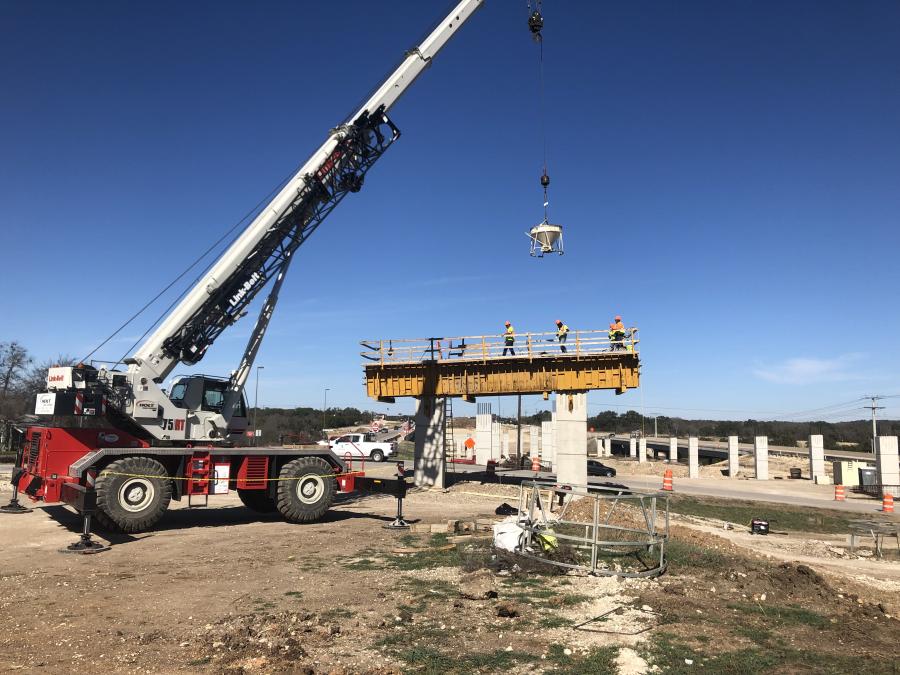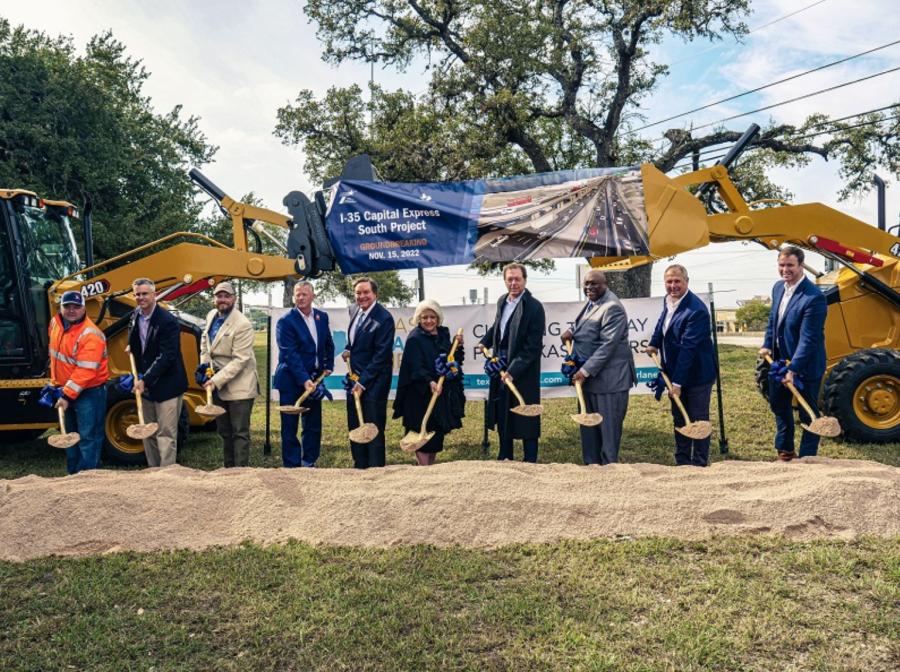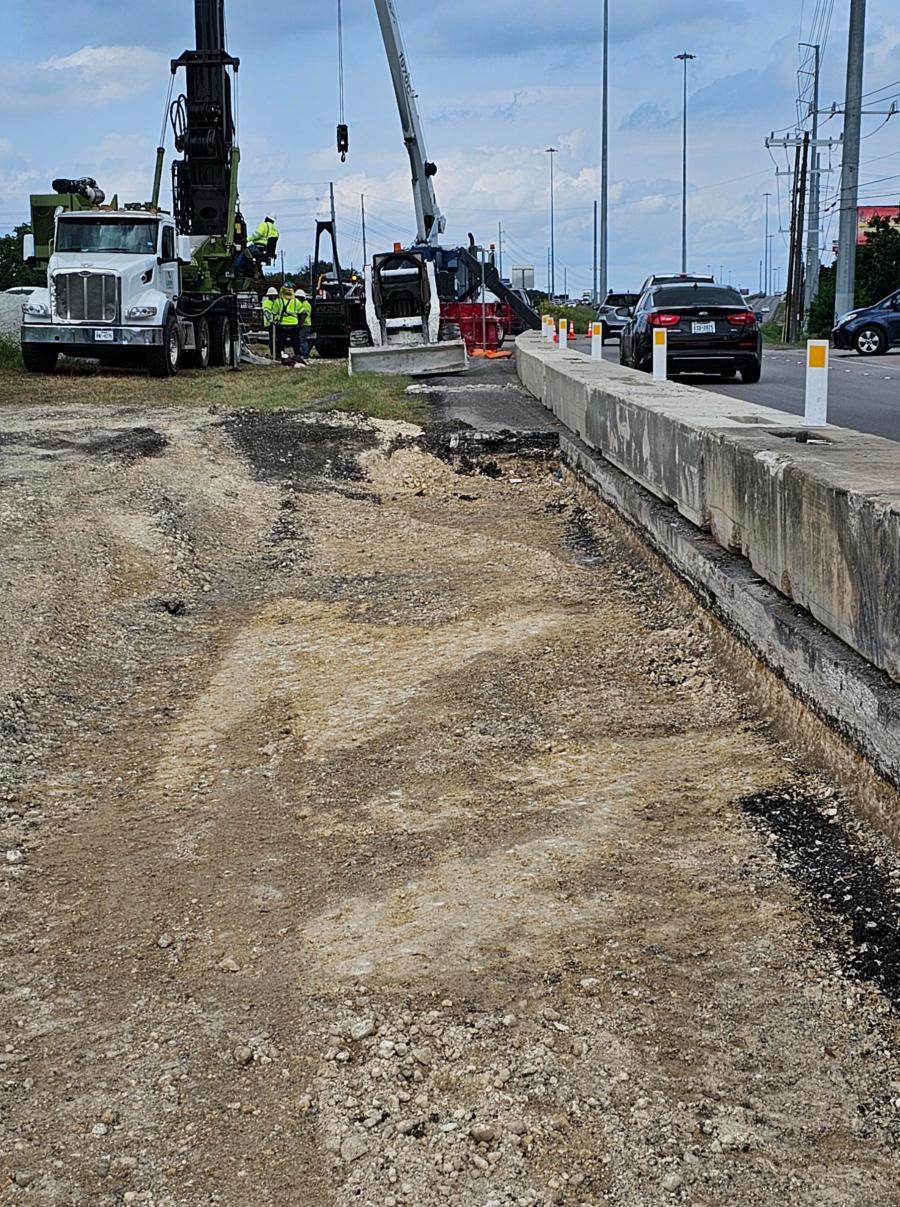Fluor Corporation is performing upgrades in Austin via the the I-35 Capital Express South project, a massive job valued at $548 million, which is part of a $4 billion reconstruction effort.
(TxDOT photo)
As part of a $4 billion effort spearheaded by the Texas Department of Transportation, Fluor Corporation began work on the I-35 Capital Express South project. This portion of the massive Lone Star State project is valued at $548 million.
The contractor is in the process of adding two non-tolled high-occupancy vehicle managed lanes in each direction along I-35 from SH 71/Ben White Boulevard to SH 45 Southeast, elevating the HOV lanes between SH 71/Ben While Boulevard and Slaughter Lane, reconstructing several bridges, constructing a southbound I-35 intersection bypass lane that will allow traffic to bypass Stassney Lane and William Cannon Drive, improving east/west connections over or under I-35 and adding approximately 13 mi. of new shared-use pedestrian and bicycle paths throughout the corridor.

The elevated managed lanes between Stassney Lane and Slaughter Lane presented one of the biggest challenges for the contractor. "These were complicated structures, both to design and to construct, given their size, shape and placement along a very congested corridor," said Ivan Baker, TxDOT project manager of the I-35 Capital Express South project. "Another design challenge involved integrating the South project with recently completed TxDOT projects like the I-35 from William Cannon Drive to Stassney Lane project. The design team developed alignments for the mainlanes, frontage roads and ramps that minimized throwaway costs by incorporating the recently constructed work into the South project design.
"The design team sought to maximize efficiency in construction using multiple methods," he added. "First, the team limited the varying sizes and shapes of beams and columns being proposed. Another method included developing a construction phasing plan that called for starting the roadway and structures work in the I-35 median to reduce the risk of delays that could occur due to right-of-way acquisitions and utility relocations along the frontage roads. The design team also sought to maximize the size of work zones to provide the necessary space for the contractor to operate."
Given the size and magnitude of the South project, the traffic management plan required extra attention and detail to minimize impacts during construction.
"The plan calls for maintaining three mainlanes of traffic in each direction along I-35 at all times," said Baker. "Any closures of the mainlanes, that are not full closures, will be short duration impacts, such as overnight or on the weekends. All closures are communicated to the public in advance and timed so as not to occur during higher traffic periods, such as holidays, UT football games, SXSW, ACL, etc."
The work is taking place in four phases. Phase I has crews constructing elevated managed lanes between SH 71/Ben White Boulevard and Slaughter Lane, reconstructing South Boggy Creek bridge, constructing a braided ramp at South Boggy Creek and relocating utilities.
Phase II will see the construction of the southbound I-35 bypass lane, widening the Slaughter Creek bridge, constructing a new Onion Creek bridge, and reconstructing entrance and exit ramps along the mainlanes and frontage roads. Phase III will focus on widening northbound and southbound I-35 frontage roads, and constructing shared-use paths throughout the corridor. Phase IV crews will perform final paving and striping.
"We're just in the beginning stages, so we are setting all of our temporary concrete barriers and doing some temporary widenings and detours to get everything set up for major Phase 1 work," said Matthew Krein, Fluor Heavy Civil's Construction's project director, who noted that this was TxDOT's largest bid-build project when the contract was awarded. "The major challenges are labor and logistics, getting all of the material and equipment in and out of the job site in a safe working manner, while trying to maintain the same number of lanes during the day to minimize the impact on the traveling public."
Utilities are being relocated and placed on both sides of the highway.
"More than half of our work will be performed at night just because of the limitations and restrictions on hours when we can close lanes on I-35," said Krein.
"Approaching the elevated section in this manner will reduce the duration of traffic impacts to the tie-in at SH 71/Ben White Boulevard," said Baker. "The elevated managed lanes are expected to take more than five years to complete, weather permitting. The overall length of the elevated section is 12,570 feet, roughly 2.4 miles and will be constructed over both Stassney Lane and William Cannon Drive bridges."
The highest section of the elevated managed lanes will be 60 ft. above the I-35 mainlanes. The height of the elevated lanes is necessary to provide the proper vertical clearance to pass over both the Stassney Lane and William Cannon Drive bridges. While the span lengths vary, the most common length is 125 ft. The longest span is 244 ft. at Williamson Creek, followed by the spans over Stassney Lane and William Cannon Drive bridges.
"The components of the substructure will be cast-in-place concrete," said Baker. "Several caps are steel to accommodate the ingress and egress ramps connected to the elevated managed lanes. The elevated section will provide two, 12 ft. lanes with 11 ft. outside shoulders and 4 ft. inside shoulders in both directions. The contractor will begin by constructing the drill shaft foundations into solid limestone, followed by columns, column capitals and caps. They will use multiple crews, working continuously, to construct the different components for each structure."
High strength structural concrete is used in all components of the elevated managed lanes. The deck's compressive strength is designated at 4,000 psi and the substructure components are designated at 3,600 psi. With proper curing, the concrete will attain full strength within seven days.
Krein explained that this work will start this summer, barring any weather issues, with the goal of completion for 2027. Work will begin at the north end of the corridor, near Stassney Lane and Williamson Creek and continue south to Boggy Creek. The shared use path for cyclists and pedestrians is adjacent to the existing roadway.
"The elevated lanes are being placed above the median, with a portion overhanging the existing lane below," he said. "One of the unique things on this job is that TxDOT specified that we use a mobile concrete traffic barriers that can be moved nightly to close lanes."
Fluor will be building large cast-in-place, hammerhead-type concrete caps to hold the typical 125-ft. long bridge spans, with the concrete supplied by a batch plant located at the south end of the project in a construction yard.
"The work follows TxDOT's typical bridge standard," said Krein.
"We have three spans that are using steel girders because they go over a creek and cross streets due to the lengths we have to achieve," said Krein.
The reconstruction of the South Boggy Creek bridge will be a phased demolition and reconstruction effort. Crews will demolish the existing culverts, reconstruct the frontage road and mainlane bridges and construct braided ramps.
"The challenges we are facing before construction include the design of the MSE walls inundated in water," said Baker. "The strap lengths for the MSE wall panels are required to be up to 36-feet long and interrupt the phasing of the traffic control plan. The bridge will be composite prestressed concrete I-girders on drilled shafts. The managed lanes will add two lanes in both directions. The new mainlanes will have three lanes in both directions. This area will also include braided entrance ramps to the managed lanes and mainlanes."
The bridge will be constructed in phases, working from the outside inwards. A cast in place substructure with prestressed concrete I-girders and combination decking will be utilized for the reconstruction.
"Crews will reconstruct the frontage road bridges while traffic is switched to the mainlanes," said Baker. "Once complete, mainlane traffic will switch to the new frontage roads as crews start working on demolishing and reconstructing the mainlanes. The mainlanes will be replaced completely through multi-staged construction."
The plan is to demolish the bridge in sections starting with the outside frontage road lanes, with construction debris removed immediately after operations.
"We're reconstructing most of the bridges over Boggy Creek," said Krein. "We'll demolish out the culvert [boxes] from underneath to keep the creek moving. "
Krein and his team have time to plan the execution of this work.
"The Boggy Creek work ties into the work on the elevated lanes," he said.
Construction of a braided ramp at South Boggy Creek is anticipated to begin in late 2024 or early 2025, weather permitting.
"The biggest challenge associated with the braided ramp is constructing the bridge within a constrained work area," said Baker. "The project team will need careful planning and construction sequencing are the critical components considering the limited amount of space."
The bridge over Onion Creek, nearly one-third of a mile in length, is also being replaced.
"We're constructing this in three phases," said Krein. "We have to demolish and leave parts of the existing bridge and then build the new bridge around it due to major traffic shifts over Onion Creek. We'll start demolition this fall and complete the new structure by mid-2027."
Many utilities will be relocated throughout the corridor such as electrical, water, wastewater and communications.
"We have overhead and underground electrical and telecom, water and sewer lines and we're moving a bunch of roadway lighting and illumination," said Krein, "as well as moving TxDOT ITS infrastructure, including all their cameras along the corridor that feed to their control center. The relocation will continue until the end of the job."
"This is an ongoing task," said Baker. "The plan is to relocate each utility with minimal impacts to the community and project."
Krein stated, "The labor market in Austin is challenging right now — there is a shortage of workers. We've been lucky in finding Fluor crews and the individuals that we have, along with our subcontractors. So far things are going well. The guys are doing a good job of working safely and getting things done."
Fluor's management team includes Mike Ortiz, the construction manager who has more than 30 years of experience, and Richard Snow, the deputy project director, also a veteran.
Demolition and excavation operations for the South project should generate approximately 40,000 tons of concrete, 100,000 tons of asphalt, 4,500 tons of steel and 600,000 tons of earth and rock.
"We are using local facilities that will separate the reinforcing steel and then crush the concrete to be used as a fill material for road base or other backfill," said Krein. "The reinforcing steel and other metal will be sent to recycling facilities and the earth and rock will be incorporated into the new construction."
New materials will include: 425,000 tons of concrete, 500,000 tons of asphalt, 20,000 tons of steel, and 130,000 linear ft. of pipe.
Busy days have 225 plus Fluor and subcontractor personnel. Major subcontractors include: Lone Star Paving, The Levy Company Inc., Light It Up Electric, J.B. Pinnacle Group LLC, Texas Highway Walls LLC, Future Infrastructure LLC, Bexar Concrete Works, W& W-AFCO Steel LLC and Fortiline Waterworks.

A fair amount of equipment will be used. This includes: a Cat 140 motor grader; a Cat 259D compact track loader; a Cat 304 mini excavator; Cat M322-F, 336F and 349F excavators; a Cat 430F backhoe; Cat D5K dozers; Cat 938M wheel loaders; Dieci 11.58 11K telehandlers; an Erie Strayer MG12 Central Concrete mix plant; a Grove 765E2 65-ton rough terrain crane and a GHC140 140-ton tele-crawler crane; a JLG 660SJ 60&39; with 6-ft. job manlift; a John Deere 245 zero swing excavator; a John Deere 310SL backhoe; a John Deere 350G excavator; a John Deere 380G excavator; a John Deere 550k dozer; John Deere 624K and 744L wheel loaders; a Link-Belt RT8080 — 80 ton tough terrain crane; a Snorkel S600X 60-ft. manlift; Sullair compressors; a Tadano GTC-2000 172-ton tele-crawler crane; truck-mounted attenuators; various Sheepsfoot and smooth drum rollers; and an Xtreme XR1255 12K telehandler.
General wear and tear includes tires, under carriage components, ground engagement tools, hydraulic lines, etc.
"The time it takes to perform repairs depends on the demand associated with the repair and the complexity of the break down," said Krein. "Most breakdowns will be addressed immediately by site mechanics. The location of the project is also close in proximity to dealers we rely on for the bulk of our fleet, so their response time is generally pretty quick also. Fluor uses a combination of on-site mechanics for general maintenance and our support system with local equipment shops and dealers for larger repairs.
"Proper use and care of equipment is the key to maintenance on long-term projects," he added. "Operator training, maintaining a strong visual inspection program, accompanied by a well-managed preventive maintenance and repair program."
Fluor purchases, rents and maintains equipment from dealerships such as RDO Equipment, H&E Equipment, Niece Equipment, United Rentals and Sunbelt Rentals, all located in Austin.
"The dealerships have great customer service," said Krein. "They offer different purchase programs, provide excellent service and are always willing to provide support. Gearing up for large projects takes a tremendous effort. Fluor has built strong relationships with our supporting dealers over the years. Fluor project leadership and equipment management continuously engage and plan with dealers for both purchase and long-term rental equipment needs to stay ahead of upcoming equipment and support needs. CEG
Irwin Rapoport
A journalist who started his career at a weekly community newspaper, Irwin Rapoport has written about construction and architecture for more than 15 years, as well as a variety of other subjects, such as recycling, environmental issues, business supply chains, property development, pulp and paper, agriculture, solar power and energy, and education. Getting the story right and illustrating the hard work and professionalism that goes into completing road, bridge, and building projects is important to him. A key element of his construction articles is to provide readers with an opportunity to see how general contractors and departments of transportation complete their projects and address challenges so that lessons learned can be shared with a wider audience.
Rapoport has a BA in History and a Minor in Political Science from Concordia University. His hobbies include hiking, birding, cycling, reading, going to concerts and plays, hanging out with friends and family, and architecture. He is keen to one day write an MA thesis on military and economic planning by the Great Powers prior to the start of the First World War.
Read more from Irwin Rapoport here.
Today's top stories



















